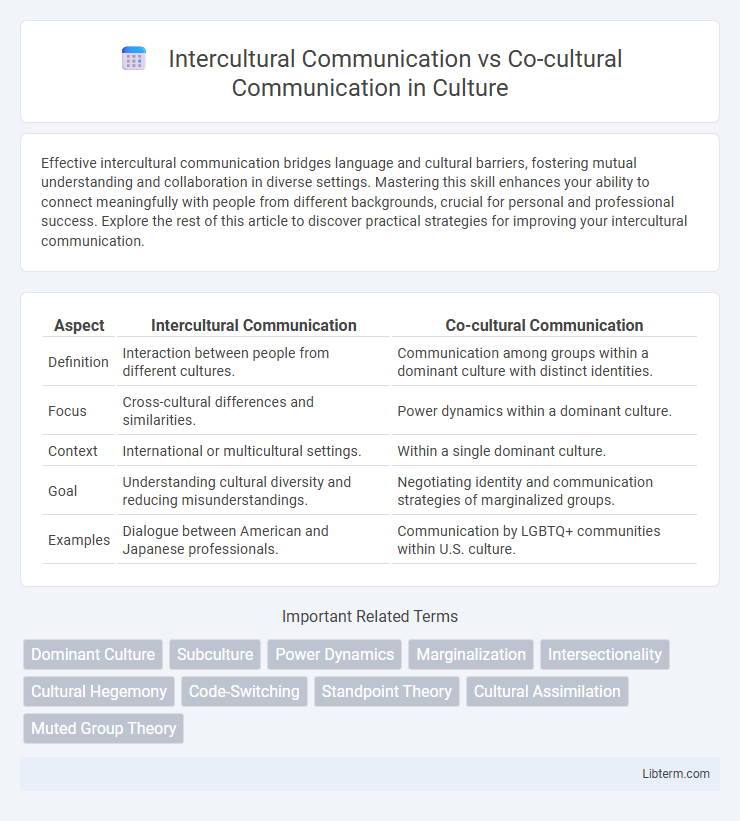Effective intercultural communication bridges language and cultural barriers, fostering mutual understanding and collaboration in diverse settings. Mastering this skill enhances your ability to connect meaningfully with people from different backgrounds, crucial for personal and professional success. Explore the rest of this article to discover practical strategies for improving your intercultural communication.
Table of Comparison
| Aspect | Intercultural Communication | Co-cultural Communication |
|---|---|---|
| Definition | Interaction between people from different cultures. | Communication among groups within a dominant culture with distinct identities. |
| Focus | Cross-cultural differences and similarities. | Power dynamics within a dominant culture. |
| Context | International or multicultural settings. | Within a single dominant culture. |
| Goal | Understanding cultural diversity and reducing misunderstandings. | Negotiating identity and communication strategies of marginalized groups. |
| Examples | Dialogue between American and Japanese professionals. | Communication by LGBTQ+ communities within U.S. culture. |
Introduction to Intercultural and Co-cultural Communication
Intercultural communication explores interactions between individuals from different cultural backgrounds, emphasizing understanding diverse values, beliefs, and communication styles. Co-cultural communication focuses on communication patterns within marginalized or minority groups in a dominant cultural context, highlighting power dynamics and identity negotiation. Both fields analyze how cultural context influences message interpretation and social behavior in diverse environments.
Defining Intercultural Communication
Intercultural communication involves the exchange of information between individuals from different cultural backgrounds, emphasizing understanding diverse cultural norms, values, and behaviors. It focuses on bridging communication gaps caused by differences in ethnicity, nationality, language, and cultural practices. Effective intercultural communication enhances global collaboration, reduces misunderstandings, and promotes cultural sensitivity across diverse populations.
Understanding Co-cultural Communication
Co-cultural communication involves interactions within marginalized or non-dominant groups that navigate power dynamics and cultural identity in dominant societal contexts. It emphasizes how individuals from co-cultural groups use communication strategies like assimilation, accommodation, or separation to negotiate their identity and social standing. Understanding co-cultural communication provides insight into the complexities of language, nonverbal cues, and intercultural adaptability required to foster inclusion and reduce misunderstandings in diverse settings.
Key Differences Between Intercultural and Co-cultural Communication
Intercultural communication involves interaction between individuals from different cultural backgrounds, focusing on understanding diverse cultural norms, values, and communication styles globally. Co-cultural communication occurs within a dominant culture where marginalized or less powerful groups communicate, emphasizing dynamics of power, identity, and social hierarchy. Key differences include intercultural communication addressing broad cultural variations across nations or ethnicities, while co-cultural communication specifically examines interactions within a single society influenced by social stratification and group identity.
The Role of Power Dynamics in Communication
Power dynamics play a crucial role in intercultural communication by influencing how dominant and marginalized cultural groups interact, often shaping language use, nonverbal cues, and access to communication channels. In co-cultural communication, power hierarchies determine which minority voices are amplified or silenced within the dominant societal structure, affecting strategies employed for effective interaction and identity expression. Understanding these power imbalances is essential for improving communication equity and fostering mutual respect across cultural and co-cultural contexts.
Barriers and Challenges in Intercultural Contexts
Intercultural communication faces barriers such as language differences, ethnocentrism, and nonverbal misinterpretations that hinder effective interaction between diverse cultural groups. Co-cultural communication encounters challenges like power imbalances, stereotyping, and exclusion within dominant cultural contexts, impacting marginalized groups' ability to express their identities. Both contexts require heightened cultural awareness and adaptive strategies to overcome misunderstandings and foster inclusive dialogue.
Strategies for Effective Co-cultural Communication
Effective co-cultural communication strategies center on active listening, cultural empathy, and adaptive language use to bridge differences between dominant and marginalized groups. Employing code-switching and context-sensitive communication enhances mutual understanding while respecting cultural identities. Emphasizing open dialogue and nonverbal sensitivity reduces misunderstandings and fosters inclusive interactions across diverse co-cultural settings.
Impact of Globalization on Communication Practices
Globalization intensifies intercultural communication by increasing interactions among diverse national cultures, requiring individuals to navigate language barriers, cultural norms, and value systems effectively. Co-cultural communication emphasizes the experiences of minority groups within dominant societies, highlighting power dynamics and identity negotiation in globalized contexts. The impact of globalization reshapes communication practices by fostering adaptive strategies that promote inclusivity and mutual understanding across both intercultural and co-cultural encounters.
Case Studies: Real-world Examples
Case studies illustrating intercultural communication highlight how individuals from different national cultures navigate language barriers and cultural norms to achieve effective collaboration, such as multinational teams overcoming misunderstandings in global corporations. Co-cultural communication case studies focus on marginalized groups within a dominant culture, demonstrating strategies like nonverbal cues and code-switching used by co-cultural group members to assert identity and negotiate power dynamics, exemplified by African American communication patterns in predominantly white workplaces. These real-world examples emphasize the importance of context-specific approaches in both intercultural and co-cultural communication to foster inclusion and reduce conflict.
Fostering Inclusive and Respectful Communication
Intercultural communication encompasses interactions between individuals from different cultural backgrounds, emphasizing awareness of diverse perspectives and reducing ethnocentrism to foster inclusion. Co-cultural communication specifically examines how marginalized or non-dominant groups communicate within a dominant culture, highlighting strategies for affirming identity and challenging power dynamics. Both frameworks promote respectful communication by encouraging empathy, active listening, and adaptability to accommodate cultural variances and support equitable dialogue.
Intercultural Communication Infographic

 libterm.com
libterm.com